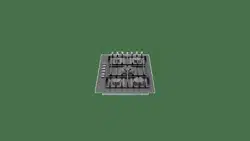Loading ...
Loading ...
Loading ...

14
▯ If the flame is completely or mostly yellow, verify that
the regulator is set for the correct fuel. After
adjustment, retest.
▯ Some yellow streaking is normal during the initial start-
up. Allow unit to operate 4 to 5 minutes and re-
evaluate before making adjustments.
▯ Foreign particles in the gas line may cause an orange
flame during initial use. This should disappear with
use. Check burner to make sure port holes are not
obstructed. If the ports are clogged ~ "Before Calling
for Service" on page 21
Note: An audible “pop” may be heard when the burner
is turned off manually. The “popping” may be louder with
LP gas than with natural gas. This is normal.
Turning off a burner
Turn the corresponding control knob clockwise to the
“off” position.
9 WARNING
If the burner flames are accidentally blown out, turn
the control knob of the burner to the “off” position
and do not try to relight it for at least 1 minute.
General Notes
It is normal to hear a soft whistling noise while the burner
is operating.
When first used, it is normal for the burner to give off
odors. This does not pose any risk and does not indicate
a malfunction. They will disappear in time.
An orange-colored flame is normal. This is caused by the
presence of dust in the atmosphere, spilled liquids, etc.
Getting the Most Out of Your Appliance
Suitable cookware
The cookware must not overhang the edge of the
cooktop.
Cookware Recommendations
Note: When using certain pots or pans, a slight and
temporary deformation of the steel cooking surface may
occur. This is normal and does not affect the functionality
of the appliance.
The following recommendations can help you save
energy and avoid damaging your cookware:
Proper Cookware
▯ Aluminum or copper bottomed pans conduct heat
evenly.
▯ Steel pans, if not combined with other metals, may
cook unevenly.
▯ Cast-iron cookware absorbs heat slowly and cooks
more evenly at low-to-medium settings.
▯ Flat heavy bottom pans provide even heat and
stability.
▯ DO NOT USE pans that are thin, warped, dented or
ridged as they heat unevenly.
Burner Minimum diame-
ter of the cook-
ware base
Maximum diame-
ter of the cook-
ware base
Dual-flame
burner
8
2
/
3
" (22 cm)
11¾" (30 cm)
Large burner 7¾" (20 cm) 10¼" (26 cm)
Medium burner 5½" (14 cm)
8
2
/
3
" (22 cm)
Small burner 4¾" (12 cm) 6¼" (16 cm)
Use the right size pans for
each burner.
Do not use small pans on
large burners. The flame
should not touch the sides
of the pan.
Do not use damaged pans
that do not sit evenly on
the cooktop. Pans may tip
over.
Only use pans with a thick,
flat base.
Do not cook without a lid
and make sure the lid is
properly placed to avoid
wasting energy.
Always make sure the pan
is well-centered on the
burner, otherwise it could
tip over.
Do not place large pans on
the burners near the
control knobs. These may
be damaged by the very
high temperatures.
Place the pans on the
burner grates, never
directly on the burner.
Make sure that the burner
grates and burner caps are
correctly placed before
using the appliance.
Pans should be placed on
the cooktop carefully.
Do not strike or place
excessive weight on the
cooktop.
OEV
OEV
Loading ...
Loading ...
Loading ...
